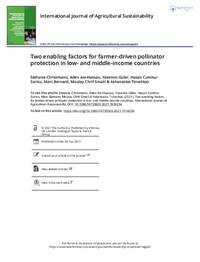Two enabling factors for farmer-driven pollinator protection in low- and middle-income countries

Authors:
Reward-based wildflower strips are the most common approach for pollinator
protection in high-income countries. Low- and middle-income countries cannot
afford this practice. A promising pilot study in Uzbekistan introduced an alternative
approach, Farming with Alternative Pollinators, focusing on farmers as target
group, marketable habitat enhancement plants and a method-inherent incentive:
higher income per surface achieved already in the first year. We hypothesized that
higher income would be a replicable enabling factor across continents, but a
knowledge-raising campaign would be necessary in many low- and middle-income
countries. We assessed the replicability of the incentive with a small number of
farmers in 2015–2016 in Morocco but focused on assessing if farmers have
sufficient knowledge to recognize wild pollinators and use this approach. We
conducted 766 interviews using a standardized questionnaire with randomly
selected smallholder farmers in three culturally different farming societies of lowand
middle-income countries (Morocco, Turkey and Benin). Farming with
Alternative Pollinators induced higher income (75% (2015), 177% (2016)) also in
Morocco. The trial and the survey show the indispensability of a knowledge-raising
campaign as the second enabling factor. However, based on capacity building,
Farming with Alternative Pollinators could have indeed high potential to promote
pollinator protection in low- and middle-income countries.
